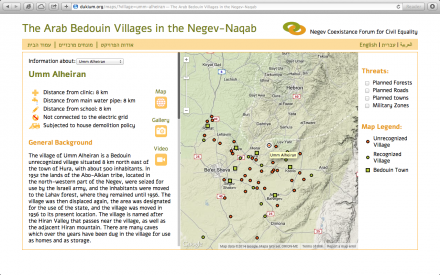
Negev Coexistence Forum for Civil Equality
פורום דו-קיום בנגב לשוויון אזרחי
منتدى التعايش السلمي في النقب من أجل المساواة المدنية
For the first time: Putting the Bedouin Unrecognized Villages of the Negev on the Map – Press Release
25.03.2014
Following the Prawer plan and other plans for settlement regulation in the Israeli Negev, the Negev Coexistence Forum (NCF) is launching a new website: The Arab-Bedouin villages in the Negev-Naqab.
On March 26 NCF will launch its documentary project of the Bedouin villages in the Negev. The project will air as an interactive, easy to operate, website which will provide information on the recognized and unrecognized Bedouin villages in the Negev. The site offers a map, text, photos, videos and more on each village in three languages – Hebrew, Arabic and English.
Click here to visit the new website
The Bedouin unrecognized villages do not appear on Israel’s formal maps and information concerning the villages is not available. In view of the various development plans for the area which jeopardize the existence of the villages, the different committees and plans which examine the ways to arrange the settlement in the Negev and the disinformation published in the media, the goal of NCF’s project is to bring together information on the villages where people interested in the subject can be exposed to basic information such as: location of the villages, the unique story of each village and the governmental services or more so the lack of services.
All the information for the site was gathered in cooperation with the committees of the unrecognized villages. NCF’s staff visited the villages, conducted tours in the villages with the residents and gathered with them the information presented in the website.
The different development plans which call for concentration of the Bedouin population in order to designate the evicted lands for roads, military bases and Jewish settlements, draw their legitimacy from the general public’s lack of knowledge and acquaintance with the everyday reality of the villages.
The goal of this site is to expose the real situation on the ground and to refute the prevailing myths about the Negev, such as the argument that the Bedouin population is dispersed in the Negev and do not live in distinctive villages.
In our view, making the information available and accessible to the public is another step in the struggle between local knowledge and facts on the ground and the misinformation spread by the authorities. Moreover, it is a big step in the struggle for recognition of the unrecognized villages in the Negev.
Michal Rotem, coordinator of the project, said today: “ In my opinion the most important step of the site is putting the Bedouin villages on the map. Not just a map but an interactive one which enables the users to click on each village and see for themselves the information the residents of the village chose to show. The authorities talk constantly on the ‘Bedouin disperion’ while the site refutes this argument by exposing the villages that the authorities wish to hide. Writing the local story of each village, together with its residents, build local and cooperative knowledge, alternative to the information usually accessible to the public”.
The launching event will take place on 26 March 2014 at 5 pm in the Multaka-Mifgash, 7 Shlomo Hamelech St., Beer Sheva. The event will include presentation of the site, meeting with the residents who took part in the project and an open discussion on the status of the Bedouin unrecognized villages in the Negev.
For details:
Michal Rotem – +972-545-851700 – Michal@dukium.org


 Youtube
Youtube
 Twitter
Twitter
 Facebook
Facebook